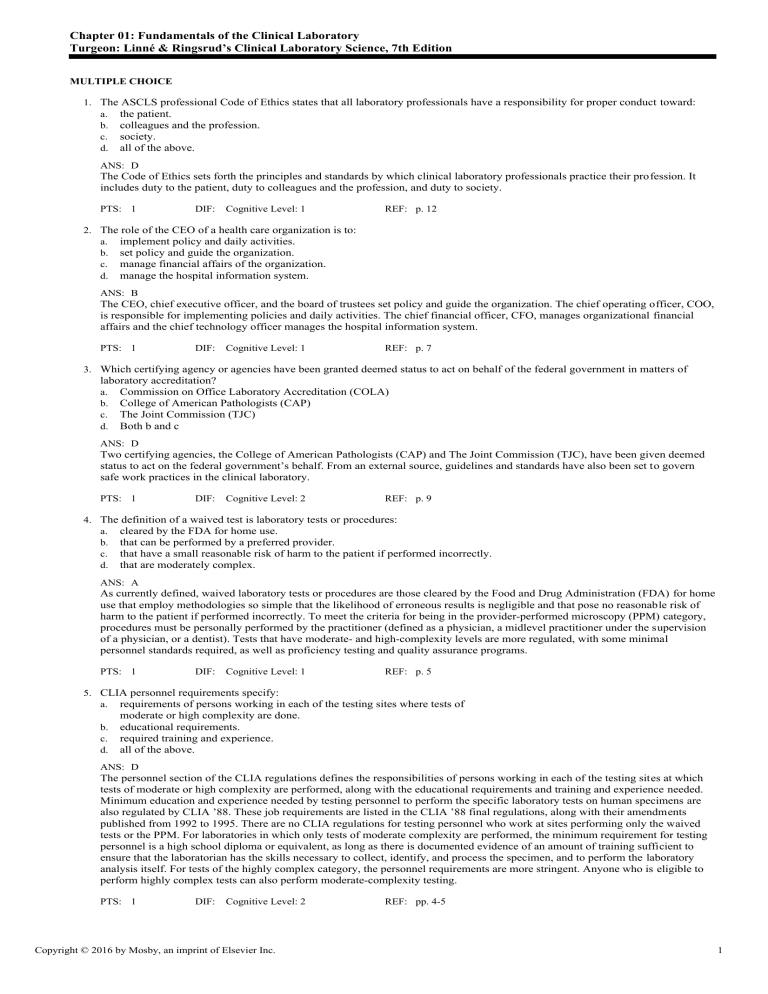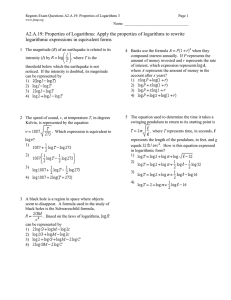
Chapter 01: Fundamentals of the Clinical Laboratory Turgeon: Linné & Ringsrud’s Clinical Laboratory Science, 7th Edition MULTIPLE CHOICE 1. The ASCLS professional Code of Ethics states that all laboratory professionals have a responsibility for proper conduct toward: a. the patient. b. colleagues and the profession. c. society. d. all of the above. ANS: D The Code of Ethics sets forth the principles and standards by which clinical laboratory professionals practice their profession. It includes duty to the patient, duty to colleagues and the profession, and duty to society. PTS: 1 DIF: Cognitive Level: 1 REF: p. 12 2. The role of the CEO of a health care organization is to: a. implement policy and daily activities. b. set policy and guide the organization. c. manage financial affairs of the organization. d. manage the hospital information system. ANS: B The CEO, chief executive officer, and the board of trustees set policy and guide the organization. The chief operating officer, COO, is responsible for implementing policies and daily activities. The chief financial officer, CFO, manages organizational financial affairs and the chief technology officer manages the hospital information system. PTS: 1 DIF: Cognitive Level: 1 REF: p. 7 3. Which certifying agency or agencies have been granted deemed status to act on behalf of the federal government in matters of laboratory accreditation? a. Commission on Office Laboratory Accreditation (COLA) b. College of American Pathologists (CAP) c. The Joint Commission (TJC) d. Both b and c ANS: D Two certifying agencies, the College of American Pathologists (CAP) and The Joint Commission (TJC), have been given deemed status to act on the federal government’s behalf. From an external source, guidelines and standards have also been set to govern safe work practices in the clinical laboratory. PTS: 1 DIF: Cognitive Level: 2 REF: p. 9 4. The definition of a waived test is laboratory tests or procedures: a. cleared by the FDA for home use. b. that can be performed by a preferred provider. c. that have a small reasonable risk of harm to the patient if performed incorrectly. d. that are moderately complex. ANS: A As currently defined, waived laboratory tests or procedures are those cleared by the Food and Drug Administration (FDA) for home use that employ methodologies so simple that the likelihood of erroneous results is negligible and that pose no reasonable risk of harm to the patient if performed incorrectly. To meet the criteria for being in the provider-performed microscopy (PPM) category, procedures must be personally performed by the practitioner (defined as a physician, a midlevel practitioner under the supervision of a physician, or a dentist). Tests that have moderate- and high-complexity levels are more regulated, with some minimal personnel standards required, as well as proficiency testing and quality assurance programs. PTS: 1 DIF: Cognitive Level: 1 REF: p. 5 5. CLIA personnel requirements specify: a. requirements of persons working in each of the testing sites where tests of b. c. d. moderate or high complexity are done. educational requirements. required training and experience. all of the above. ANS: D The personnel section of the CLIA regulations defines the responsibilities of persons working in each of the testing sites at which tests of moderate or high complexity are performed, along with the educational requirements and training and experience needed. Minimum education and experience needed by testing personnel to perform the specific laboratory tests on human specimens are also regulated by CLIA ’88. These job requirements are listed in the CLIA ’88 final regulations, along with their amendments published from 1992 to 1995. There are no CLIA regulations for testing personnel who work at sites performing only the waived tests or the PPM. For laboratories in which only tests of moderate complexity are performed, the minimum requirement for testing personnel is a high school diploma or equivalent, as long as there is documented evidence of an amount of training sufficient to ensure that the laboratorian has the skills necessary to collect, identify, and process the specimen, and to perform the laboratory analysis itself. For tests of the highly complex category, the personnel requirements are more stringent. Anyone who is eligible to perform highly complex tests can also perform moderate-complexity testing. PTS: 1 DIF: Cognitive Level: 2 Copyright © 2016 by Mosby, an imprint of Elsevier Inc. REF: pp. 4-5 1 6. The fastest growing segment of laboratory testing is: a. dry reagent chemistry. b. lab on a chip technology. c. molecular diagnostics. d. automation of blood cell counting. ANS: C In the 21st century, molecular diagnosis is the hottest topic in the clinical laboratory. PTS: 1 DIF: Cognitive Level: 1 REF: p. 7 7. Informed consent upon patient’s hospital admission can encompass: a. agreement to the nature of the testing to be done. b. agreement to what will be done with laboratory test results. c. implied consent to many routine procedures that may be performed. d. all of the above. ANS: D For laboratories, an important responsibility is obtaining informed consent from the patient. Informed consent means that the patient is aware of, understands, and agrees to the nature of the testing to be done and what will be done with the results reported. Generally, when a patient enters a hospital, there is an implied consent to the many routine procedures that will be performed while the patient is in the hospital. Venipuncture is one of the routine tests that carry this implied consent. PTS: 1 DIF: Cognitive Level: 2 REF: p. 10 8. The federal legislation requiring strict confidentiality of patient results is: a. Clinical Laboratory Improvement Act (CLIA ’88). b. Health Insurance Portability and Accountability Act (HIPAA). c. National Certifying Agency. d. combined state laws. ANS: B The Health Insurance Portability and Accountability Act (HIPAA) enacted in 1996 requires that any results obtained for specimens from patients must be kept strictly confidential. Any information about the patient, including the types of measurements being done, must also be kept in confidence. Clinical Laboratory Improvement Act (CLIA ’88) regulates laboratory testing. The National Certifying Agency grants professional certification to individuals. HIPAA legislation supersedes any and all state laws regarding confidentiality. PTS: 1 DIF: Cognitive Level: 1 REF: pp. 10-11 9. The revised CLIA ’88 and HIPAA regulations give patients: a. the right to access their own laboratory reports. b. the right to give a personal representative the patient’s completed test reports. c. the right to refuse laboratory testing. d. both a and b. ANS: D The new rule revises CLIA ’88 and HIPAA privacy rules to require laboratories to give a patient, or a person designated by the patient or his or her “personal representative,” access to the patient’s completed test reports on the patient’s or the representative’s request. Generally, the rule requires that laboratories provide individuals with access to their laboratory test reports within 30 days of the request. PTS: 1 DIF: Cognitive Level: 2 REF: p. 11 10. Chain of custody is defined as: a. physical transport of a specimen needed for legal reasons. b. escorting patients who are prison inmates. c. beginning with the moment the specimen is collected and transported to the d. laboratory, to the analysis itself and the reporting of the results, each step must be documented. documentation of quality control when reporting a patient’s laboratory results. ANS: C Laboratory test results that could potentially be used in a court of law—at a trial or judicial hearing—must be handled in a specific manner. For evidence to be admissible, each step of the analysis, beginning with the moment the specimen is collected and transported to the laboratory, to the analysis itself and the reporting of the results, must be documented—a process known as maintaining the chain of custody. Specimens that provide alcohol levels, specimens collected from rape victims, specimens for paternity testing, and specimens submitted from the medical examiner’s cases are the usual types requiring “chain-of-custody” documentation. PTS: 1 DIF: Cognitive Level: 1 Copyright © 2016 by Mosby, an imprint of Elsevier Inc. REF: p. 11 2 11. Situational ethics is a system of judging acts: a. by strict principles. b. by categorical principles. c. within a context. d. by legal principles. ANS: C Situational ethics is a system of ethics by which acts are judged within their contexts instead of by categorical principles. Hospitals have ethics committees to evaluate situational ethics cases. Individual laboratory professionals may need to make decisions based on personal or professional values. PTS: 1 DIF: Cognitive Level: 1 REF: p. 12 MATCHING Match the following sections of the clinical laboratory with a representative test or assay for that section. Use an answer only once. a. hematology b. clinical chemistry c. immunohematology d. immunology and serology e. microbiology 1. 2. 3. 4. 5. measures blood glucose and cholesterol levels counts blood cells determines blood groups screens for strep throat infections screens for viral diseases, for example, HIV 1. ANS: REF: 2. ANS: REF: 3. ANS: REF: 4. ANS: REF: 5. ANS: REF: B p. 6 A p. 6 C p. 6 E p. 6 D p. 6 PTS: 1 DIF: Cognitive Level: 1 PTS: 1 DIF: Cognitive Level: 1 PTS: 1 DIF: Cognitive Level: 1 PTS: 1 DIF: Cognitive Level: 1 PTS: 1 DIF: Cognitive Level: 1 Match the following acronyms with its full name. Use an answer only once. a. American Society for Clinical Laboratory Science b. National Accrediting Agency for Clinical Laboratory Sciences c. American Society of Clinical Pathologists 6. ASCP 7. ASCLS 8. NAACLS 6. ANS: REF: 7. ANS: REF: 8. ANS: REF: C p. 2 A p. 2 B p. 2 PTS: 1 DIF: Cognitive Level: 1 PTS: 1 DIF: Cognitive Level: 1 PTS: 1 DIF: Cognitive Level: 1 Copyright © 2016 by Mosby, an imprint of Elsevier Inc. 3




